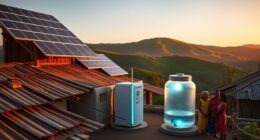Solar-driven steam reforming could potentially be adapted for residential use by utilizing compact solar concentrators and high-temperature reactors with integrated heat storage. While technical challenges like managing fluctuating sunlight, ensuring durability, and miniaturizing systems exist, advances in materials and innovative designs make small-scale reformers more feasible. If you explore further, you’ll discover how ongoing research aims to bring efficient, affordable home-based hydrogen production closer to reality.
Key Takeaways
- Solar-driven steam reforming typically requires high temperatures and large solar concentrators, challenging for residential-scale implementation.
- Advances in static, lightweight solar concentrator designs could enable small, home-compatible reforming systems.
- Integrating thermal energy storage stabilizes reactor operation, making residential hydrogen production more feasible.
- Current technological gaps include material durability, catalyst stability, and cost-effective miniaturization for home use.
- While promising for decentralized hydrogen supply, residential solar reforming remains experimental and faces significant scalability hurdles.
Understanding Solar-Driven Steam Reforming Technology

Understanding solar-driven steam reforming technology involves examining how solar energy is harnessed and integrated into chemical processes to produce hydrogen. You’ll see that reactors use solar concentrators like linear Fresnel collectors to focus sunlight as heat. Inside, tubular or shell-and-tube structures hold catalysts and separate reaction zones, while hydrogen membranes enable simultaneous hydrogen separation, boosting efficiency. To maximize solar absorption, reactors often have transparent outer walls, allowing sunlight to reach the catalyst bed directly. Heat transfer fluids, such as molten salts, carry thermal energy to sustain high temperatures needed for reforming. These salts also serve as thermal storage, ensuring continuous operation during cloudy periods or at night. Proper design balances solar input and heat management, making the process effective and adaptable. Additionally, attention to environment and safety considerations is essential for sustainable implementation.
Benefits of Solar Thermal Energy for Hydrogen Production

Using solar thermal energy for hydrogen production offers a clean and renewable alternative to fossil fuels. It achieves high conversion efficiency by directly transforming solar heat into chemical energy, reducing waste. Plus, it markedly cuts emissions, helping you lower your carbon footprint and support a sustainable future. Utilizing high temperatures up to 1,500°C, solar thermochemical processes can efficiently split water into hydrogen and oxygen, maximizing energy use. Incorporating advanced solar concentrators can enhance heat collection and improve overall system performance.
Renewable Energy Source
Solar thermal energy offers a renewable and sustainable way to produce hydrogen, harnessing sunlight instead of fossil fuels. By using solar heat, you reduce reliance on natural gas and help prevent resource depletion. Solar reactors can reach temperatures up to 1,500°C, enabling efficient thermochemical water splitting without emitting CO2. This process uses water as the feedstock, avoiding carbon emissions associated with hydrocarbon-based methods. It supports a carbon-neutral hydrogen cycle, aligning with global decarbonization objectives. Furthermore, solar-driven hydrogen production markedly cuts greenhouse gases compared to conventional techniques, producing no direct CO2 emissions. Incorporating thermal energy storage allows continuous operation, further enhancing environmental benefits. This approach promotes a clean energy shift, making hydrogen production more sustainable and environmentally friendly for residential and industrial applications. Advances in high-temperature solar concentrators and materials are enhancing the efficiency and feasibility of these systems worldwide, making solar-driven processes increasingly viable as a future energy solution.
High Conversion Efficiency
Recent advancements in solar thermal technology have dramatically increased the efficiency of hydrogen production, with systems now achieving conversion rates as high as 42%. This jump results from improved system designs that reduce heat loss and optimize the use of concentrated solar heat. You can benefit from these efficiencies in several ways:
- Solar-to-hydrogen efficiencies of up to 40–42% are achievable, considerably surpassing earlier benchmarks.
- Experimental setups using seawater reach around 12.6% efficiency by combining photovoltaic and thermal processes.
- Pilot reactors at EPFL demonstrate over 20% conversion efficiency under real sunlight, producing more hydrogen at higher power rates.
- The increasing importance of regional resources and local expertise can further enhance the deployment and effectiveness of these systems.
These improvements mean more hydrogen from less solar input, making solar-driven steam reforming increasingly viable for residential and decentralized applications.
Emission Reduction Benefits
By harnessing solar thermal energy for hydrogen production, you substantially reduce greenhouse gas emissions compared to traditional fossil fuel-based methods. Solar-driven steam reforming produces hydrogen without CO₂ emissions because it uses sunlight instead of fossil fuels. Hybrid processes further cut emissions by replacing fossil fuel heat with solar energy. This aligns with decarbonization goals for transport and industry, helping you lower your carbon footprint. Additionally, solar methods avoid pollutant discharges common in fossil-based processes, improving environmental quality. Solar hydrogen is a renewable, sustainable option that depends on abundant sunlight, offering a clean alternative to fossil fuels. Using solar energy also enhances energy security and supports scalable, green hydrogen production, making it a practical solution for reducing overall emissions while meeting growing energy demands. Renewable energy sources play a crucial role in advancing sustainable hydrogen technologies.
Technical Challenges in Miniaturizing Solar Reformers

Miniaturizing solar reformers presents several technical challenges that stem from the need to efficiently manage heat transfer, catalyst stability, and device design at smaller scales. First, fluctuating solar fluxes affect temperature regulation, requiring precise thermal management systems. Second, designing compact heat transfer paths—like curved channels—demands meticulous engineering to ensure uniform heating. Third, selecting durable, cost-effective materials is critical to withstand high temperatures and prevent degradation. Additionally, maintaining catalyst stability is essential, as sintering and carbon buildup can deactivate catalysts over time. Ensuring uniform catalyst dispersion and scalability also pose hurdles. Moreover, effective fraud prevention tools can be adapted to monitor and secure critical systems in innovative energy devices. Overall, balancing efficiency, stability, and cost in a miniature device involves overcoming complex heat transfer issues, material limitations, and innovative design constraints.
Potential Applications for Residential Hydrogen Use

You can generate hydrogen at home to store energy or power appliances, increasing your energy independence. Integrating hydrogen into your heating, cooking, or lighting systems offers a cleaner alternative to fossil fuels. With proper infrastructure, residential hydrogen use could transform how you manage energy and reduce environmental impact. Current technological advancements are making small-scale electrolysis more feasible for individual households, paving the way for decentralized hydrogen production. Additionally, advancements in electrolysis efficiency are helping to lower costs and improve the viability of residential hydrogen generation.
Home Hydrogen Generation
Have you ever wondered how residential hydrogen generation could transform household energy use? As technology advances, producing hydrogen at home becomes more feasible. Here’s what you should know:
- You could store excess solar energy as hydrogen, boosting your self-consumption and reducing reliance on the grid.
- Hydrogen fuel cells can power your home during outages, providing a clean backup energy source.
- You might even fuel personal hydrogen vehicles or fuel cell bikes right from your garage.
- Growing interest in decentralization is driving innovation in small-scale hydrogen production systems suitable for home use. Additionally, advancements in solar-driven electrolysis are making sustainable hydrogen generation more practical and affordable for residential settings.
While costs and infrastructure remain challenges, innovations like modular systems and solar-driven electrolysis are making residential hydrogen more accessible. Policies and investments support this shift, promising a future where hydrogen could become a key part of your home energy system.
Residential Energy Integration
Residential hydrogen use offers promising opportunities for integrating renewable energy sources into home systems. It can serve as a long-duration energy storage, helping to balance grid fluctuations when renewables produce excess power. Fuel cells powered by hydrogen provide both electricity and heat, offering backup power and enhancing energy resilience. Green hydrogen, produced via efficient electrolyzers, is rapidly advancing, supporting future residential deployment. Government initiatives like the DOE’s H2@Scale accelerate research and infrastructure development, opening new possibilities. But challenges remain: hydrogen blending limits, safety concerns, high costs, and infrastructure needs hinder widespread adoption. Innovations in electrolyzer technology and compact fuel cells could overcome these barriers, turning residential hydrogen integration into a practical, sustainable energy solution. Additionally, implementing cybersecurity measures in hydrogen systems is crucial to protect against potential digital vulnerabilities in the evolving energy infrastructure.
Designing Compact Solar Concentrators for Homes

How can homeowners harness sunlight efficiently without bulky equipment? The key is designing compact solar concentrators tailored for residential use. Here are three essential strategies:
- Use static, non-tracking designs with high concentration ratios and wide acceptance angles, making installation simpler and more reliable. Incorporating acceptance angle optimization techniques can significantly improve system performance across varying sun positions.
- Incorporate lightweight, flexible materials like aluminized Mylar films shaped into paraboloids, reducing weight and costs.
- Opt for flat reflecting walls instead of fully parabolic reflectors, which are easier to fabricate and can boost power output by nearly 200%. In addition, utilizing simple geometric shapes like truncated reflectors can help optimize the acceptance angle while maintaining high concentration. These principles enable effective solar concentration in small spaces, making steam reforming feasible at home. Combining simple materials with clever shapes maximizes efficiency while keeping the system portable and affordable.
Integrating Heat Storage for Reliable Operation
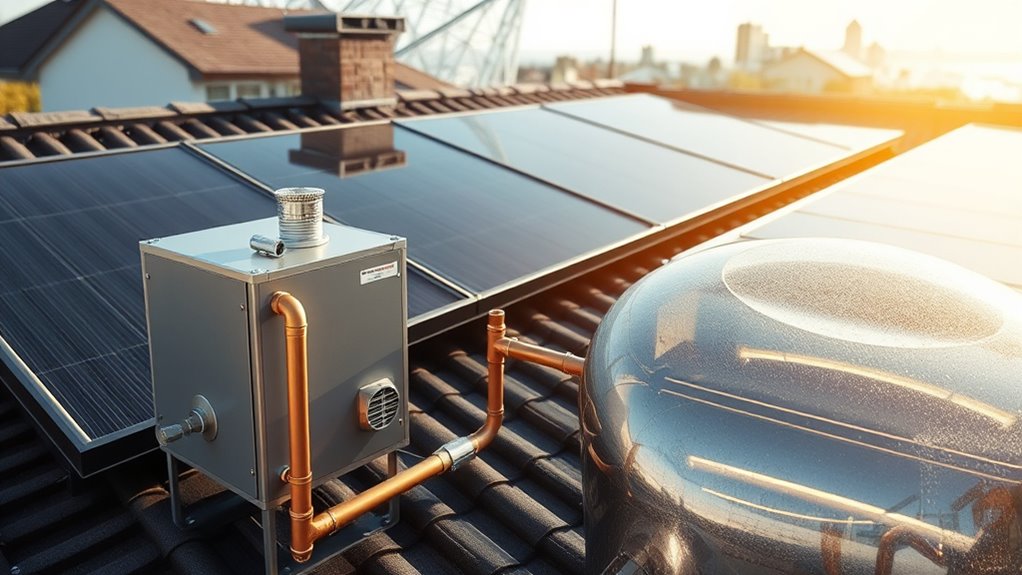
By integrating heat storage, you can smooth out fluctuations in solar energy, ensuring continuous operation even when sunlight is unavailable. This buffering stabilizes the system, maintaining consistent temperatures for efficient steam reforming. As a result, your setup becomes more reliable and better suited for consistent hydrogen production. Solar energy’s high utilization value and wide radiation range further support the feasibility of residential-scale solar reforming systems.
Buffering Solar Variability
To guarantee reliable operation of solar-driven steam reforming amid the inherent variability of solar radiation, integrating heat storage systems plays a crucial role. Using molten salts as both heat transfer fluid and thermal storage medium helps buffer solar fluctuations by storing excess heat during peak sunlight and releasing it when sunlight diminishes. This approach ensures continuous hydrogen production despite intermittent solar input. Specifically, heat storage strategies offer:
- Stabilized reactor temperatures, preventing thermal shocks.
- Extended operation during cloudy or low-sun periods.
- Improved system resilience and efficiency by smoothing out solar variability.
Molten salt loops have proven effective at maintaining stable heat supply, supporting consistent reforming reactions. Molten salts can operate at high temperatures, making them ideal for maintaining process stability. This buffering capability enhances system reliability, making residential solar steam reforming more feasible and dependable.
Enhancing System Stability
Integrating heat storage into solar-driven reforming systems considerably enhances their stability by decoupling heat supply from fluctuating solar input. Using molten salts as thermal energy storage (TES) media allows you to store heat during peak sunlight and release it when sunlight dips, maintaining consistent reactor temperatures. Two-tank TES systems enable continuous operation by smoothing out solar fluctuations, which minimizes start-up and shutdown stresses. Properly designed TES and heat exchangers ensure efficient thermal coupling, supporting steady hydrogen production. Coupling TES with concentrating solar power (CSP) plants provides a reliable, high-temperature heat source. This setup guarantees stable reformer operation, reduces thermal cycling, and enhances overall system resilience, making solar-driven steam reforming more practical and dependable for residential applications.
Cost Considerations and Economic Viability at Home Scale
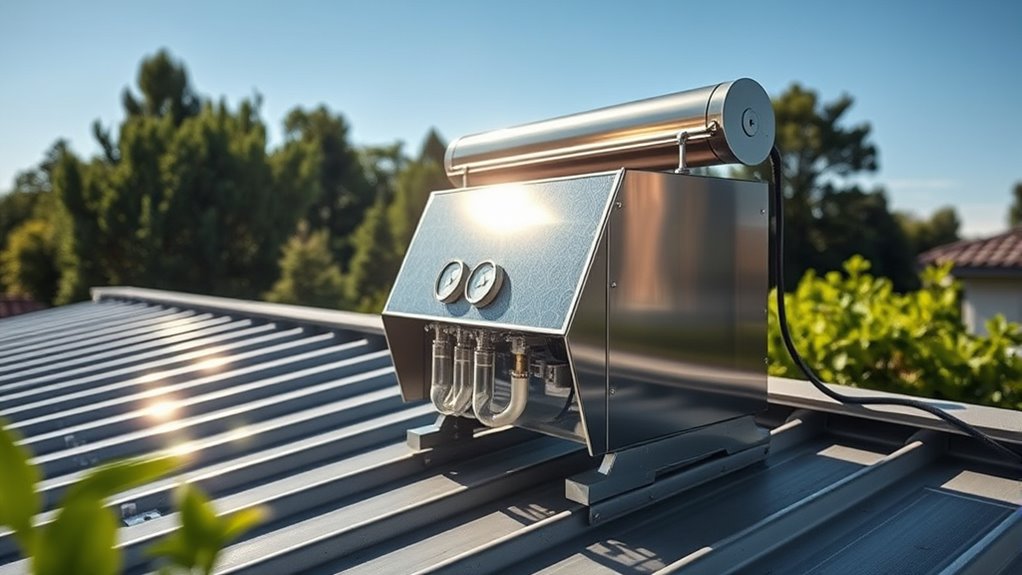
The cost considerations and economic viability of residential solar-driven steam reforming (SSR) are significant hurdles that influence its adoption. First, the initial investment includes solar concentrators, reformers, and system components, which are costly at small scales due to the lack of economies of scale. Second, integrating SSR with existing home systems adds complexity and expense, especially for water and gas connections. Third, ongoing operating costs—like maintenance, catalyst replacement, and system monitoring—raise expenses, particularly as weather variability impacts efficiency. While technological advances and mass production could lower costs over time, current prices remain high compared to grid electricity or traditional hydrogen. Your decision to adopt depends on local energy prices, incentives, and potential savings from reduced emissions, but long payback periods pose a challenge.
Current State of Residential-Scale Solar Reforming Systems
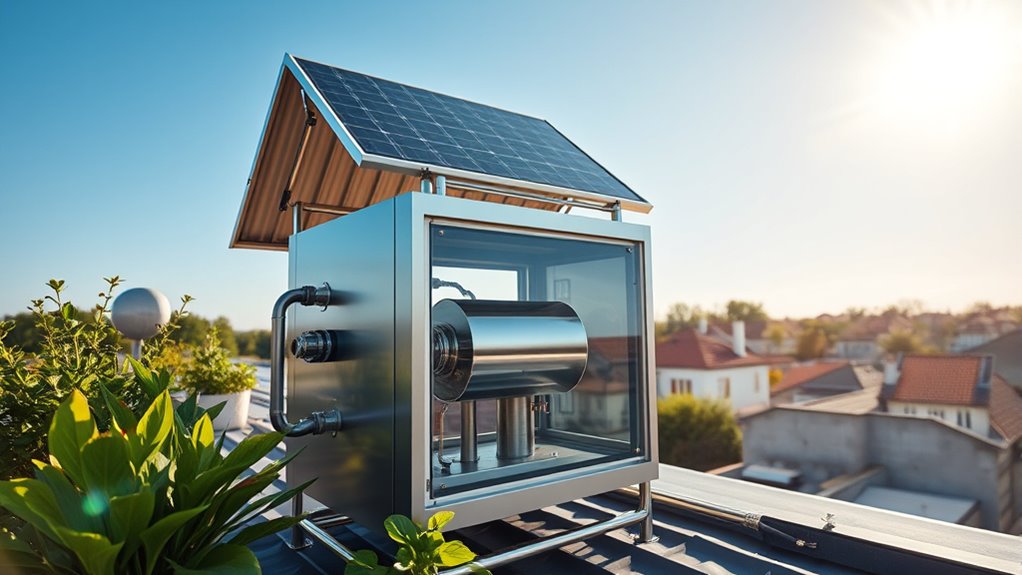
Currently, residential solar steam reforming systems remain largely in the pilot and demonstration phases, with few commercial products available for home use. Most efforts focus on industrial-scale projects, like Synhelion and Wood’s collaborations, which aim to replace combustion with solar thermal energy for hydrogen production. Particle-based concentrated solar thermal (CSP) technologies are under development to improve high-temperature heat transfer, essential for reforming processes. Residential solar PV-plus-storage systems are mature but don’t yet incorporate steam reforming, which requires higher thermal input. Although integrated biogas reforming concepts exist, practical residential implementations are experimental. These systems face challenges such as space constraints, solar variability, and the need for continuous high-temperature heat, making widespread residential adoption unlikely in the near term. Advancements in solar thermal storage are also being explored to address the intermittency issues associated with solar energy, which could eventually support more consistent reforming operations.
Future Innovations to Enable Household Hydrogen Production
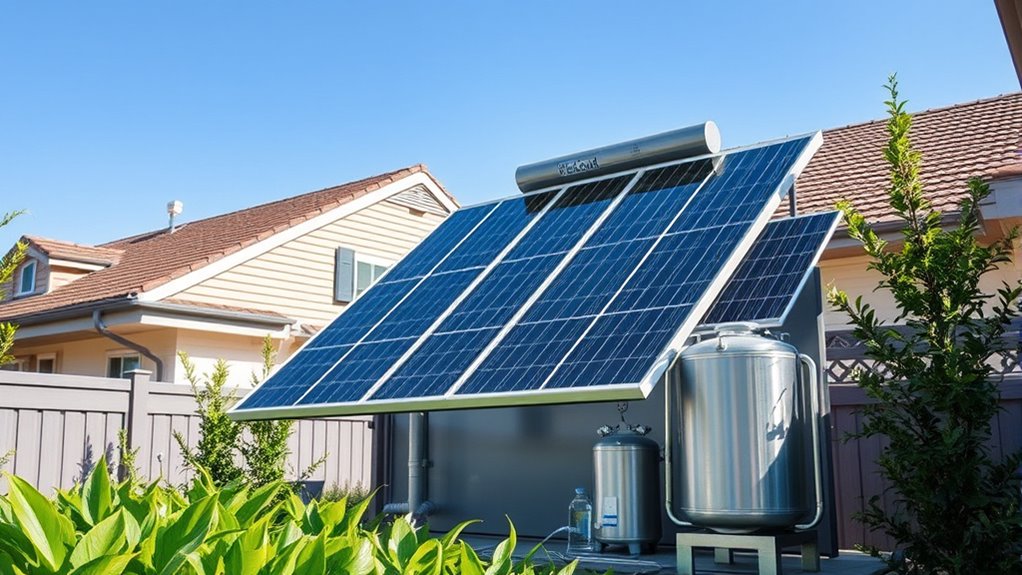
Advancements in electrolysis technologies are key to making household hydrogen production practical and efficient. First, Solid Oxide Electrolyzers (SOE) operate at high temperatures, boosting efficiency by utilizing solar thermal input. Second, Thermal Plasma Electrolysis (TPE) uses 80% less power than traditional methods and produces zero CO₂ emissions, making it ideal for modular homes. Third, Proton Exchange Membrane (PEM) electrolyzers are shrinking in size and cost, increasing their suitability for residential use. Integrating these systems with solar thermal setups can directly convert solar heat into hydrogen, reducing electricity needs. Ongoing research also focuses on lowering the costs of electrolyzers, making on-site hydrogen production more affordable for households. These innovations are essential for creating scalable, affordable solutions that make household-scale hydrogen generation feasible and sustainable.
Pathways Toward Commercial and Residential Adoption
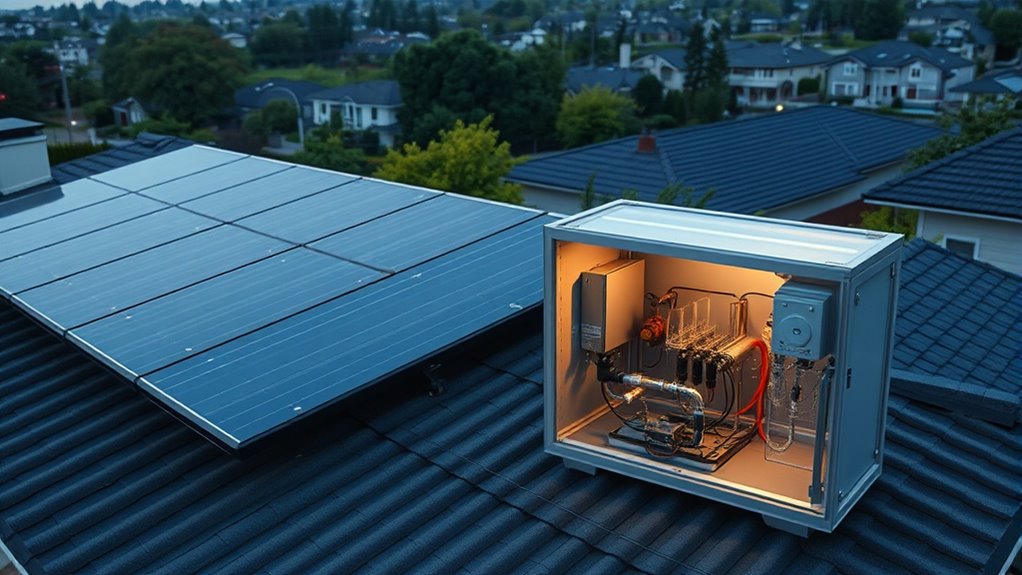
Integrating solar steam reforming (SRM) into residential and small-scale commercial settings offers promising pathways for decentralized hydrogen production. Using concentrated solar energy as a heat source, you can leverage mature SRM technology to produce low-carbon hydrogen efficiently. Key parameters like temperature, pressure, and steam-to-methane ratios influence hydrogen yield and process efficiency, which can be optimized for small-scale systems. Solar tower concentrating systems and direct normal irradiance are critical for achieving high operating temperatures necessary for effective reforming. Hybrid systems combining solar with biomass or natural gas further improve efficiency and flexibility, adapting to variable energy demands. By advancing thermodynamic efficiencies and reducing carbon footprints, these pathways move toward making household hydrogen production practical, economically viable, and environmentally sustainable.
Frequently Asked Questions
What Is the Expected Lifespan of Residential Solar Reformers?
You’re wondering about the lifespan of residential solar reformers. Based on current data and analogies with solar panels, you can expect these systems to last around 25-30 years with proper maintenance. Factors like material quality, environmental conditions, and regular upkeep influence their longevity. While some components might need replacement over time, advancements in technology could help extend their operational life and keep them efficient throughout their lifespan.
How Safe Are Household Hydrogen Storage Systems?
Think of your home as a fortress, where safety is the shield guarding your family. Household hydrogen storage systems are designed with rigorous standards, like SAE J2579 and UN regulations, ensuring minimal risks. You’ll benefit from advanced leak detection, ventilation, and automated safety controls. Regular maintenance, training, and monitoring keep hazards at bay, making your home a secure haven where clean energy fuels your life without compromising safety.
Can Existing Home Roofs Support Solar Concentrator Installation?
You ask if existing home roofs can support solar concentrator installation. To determine this, check if your roof’s condition is good, free of damage or leaks. Confirm it’s structurally sound and has enough unobstructed space, especially on the south side. Consider the roof’s material, pitch, and local regulations. Proper planning for support structures, heat management, and safety features is essential to successfully install and operate solar concentrators on your home.
What Are the Maintenance Requirements for Residential Solar Reformers?
To maintain your residential solar reformers, you need to clean them regularly with soft brushes or sponges and mild detergents, especially during early mornings or late afternoons. Inspect for physical damage, loose mounts, or wiring issues, and keep an eye on inverter performance. Recalibrate sensors and track energy output to guarantee efficiency. Seasonal repositioning and professional annual inspections help maximize lifespan and performance, keeping your system running smoothly.
Are There Government Incentives for Adopting Residential Solar Hydrogen Systems?
Right now, government incentives for residential solar hydrogen systems are limited. The residential solar tax credit is set to expire at the end of 2025, and legislative proposals might eliminate these incentives altogether. While energy storage credits remain available until 2033, the overall support for residential solar hydrogen is diminishing. You should act soon if you want to benefit from current incentives, but future support could be uncertain.
Conclusion
As solar-driven steam reforming inches closer to home, you’ll wonder just how soon you can harness this clean energy. The tech’s promise is clear, but hurdles remain—yet breakthroughs are on the horizon. Will you be among the first to power your home with sunlight and hydrogen? The future’s unfolding quickly, and the next big leap could change everything. Stay tuned—your journey into sustainable living might be closer than you think.
I’m Theodore, and I love tiny houses. In fact, I’m the author of Tiny House 43, a book about tiny houses that are also tree houses. I think they’re magical places where imaginations can run wild and adventures are just waiting to happen.
While tree houses are often associated with childhood, they can be the perfect adult retreat. They offer a cozy space to relax and unwind, surrounded by nature. And since they’re typically built on stilts or raised platforms, they offer stunning views that traditional homes simply can’t match.
If you’re looking for a unique and romantic getaway, a tree house tiny house might just be the perfect option.








